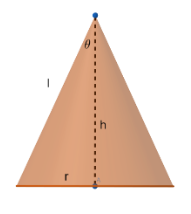
Show that semi-vertical angle of right circular cone of given surface area and maximum volume a given slant height $l$ is ${{\tan }^{-1}}\left( \dfrac{1}{2\sqrt{2}} \right)$.
Answer
605.4k+ views
Hint: First find the surface area of the cone. After that, take $l=\sqrt{{{h}^{2}}+{{r}^{2}}}$ and compare to get the volume. Then for maximum volume, $\dfrac{dV}{dr}=0$, from this you will get the value of $S$ and substitute in $l$, you will get the value of $l$ in terms of $r$ and also you will get the value of $h$. The take $\tan $ of semi vertical angle and you will get the answer.
Complete step-by-step answer:

Now the surface area of the cone will be $S=\pi {{r}^{2}}+\pi rl$ where r is the radius and l is the slant height of the cone.
Now $l=\dfrac{S-\pi {{r}^{2}}}{\pi r}$……….. (1)
Also from above figure we know that ${{h}^{2}}+{{r}^{2}}={{l}^{2}}$, where $h$ is the vertical height of the cone.
So we get, $l=\sqrt{{{h}^{2}}+{{r}^{2}}}$ ……….(2)
From (1) and (2), we get,
$\sqrt{{{h}^{2}}+{{r}^{2}}}=\dfrac{S-\pi {{r}^{2}}}{\pi r}$
Squaring both sides we get,
\[\begin{align}
& {{h}^{2}}+{{r}^{2}}={{\left( \dfrac{S-\pi {{r}^{2}}}{\pi r} \right)}^{2}} \\
& {{h}^{2}}=\left( \dfrac{{{S}^{2}}+{{\pi }^{2}}{{r}^{4}}-2\pi S{{r}^{2}}}{{{\pi }^{2}}{{r}^{2}}} \right)-{{r}^{2}} \\
& {{h}^{2}}=\left( \dfrac{{{S}^{2}}+{{\pi }^{2}}{{r}^{4}}-2\pi S{{r}^{2}}-{{\pi }^{2}}{{r}^{4}}}{{{\pi }^{2}}{{r}^{2}}} \right) \\
& {{h}^{2}}=\left( \dfrac{{{S}^{2}}-2\pi S{{r}^{2}}}{{{\pi }^{2}}{{r}^{2}}} \right) \\
& h=\dfrac{\sqrt{{{S}^{2}}-2\pi S{{r}^{2}}}}{\pi r} \\
\end{align}\]
Now volume of cone V$=\dfrac{1}{3}\pi {{r}^{2}}h=\dfrac{1}{3}\pi {{r}^{2}}\dfrac{\sqrt{{{S}^{2}}-2\pi S{{r}^{2}}}}{\pi r}$
V$=\dfrac{r}{3}\sqrt{{{S}^{2}}-2\pi S{{r}^{2}}}$
For maximum volume, $\dfrac{dV}{dr}=0$.
$\begin{align}
& \dfrac{1}{3}\sqrt{{{S}^{2}}-2\pi S{{r}^{2}}}+\dfrac{r}{3}\dfrac{-4\pi Sr}{2\sqrt{{{S}^{2}}-2\pi S{{r}^{2}}}}=0 \\
& \dfrac{1}{3}\sqrt{{{S}^{2}}-2\pi S{{r}^{2}}}=\dfrac{r}{3}\dfrac{2\pi Sr}{\sqrt{{{S}^{2}}-2\pi S{{r}^{2}}}} \\
& {{S}^{2}}=4\pi S{{r}^{2}} \\
\end{align}$
we know that, $S\ne 0$.
So $S=4\pi {{r}^{2}}$
Now taking (1) and substituting the $S=4\pi {{r}^{2}}$ we get,
$l=\dfrac{4\pi {{r}^{2}}-\pi {{r}^{2}}}{\pi r}=3r$
So $l=\sqrt{{{h}^{2}}+{{r}^{2}}}$
$\begin{align}
& 9{{r}^{2}}={{h}^{2}}+{{r}^{2}} \\
& h=2\sqrt{2}r \\
\end{align}$
Now, let $\theta $ be the semi-vertical angle of the cone.
$\begin{align}
& \tan \theta =\dfrac{r}{h}=\dfrac{r}{2\sqrt{2}r} \\
& \tan \theta =\dfrac{1}{2\sqrt{2}} \\
\end{align}$
So $\theta ={{\tan }^{-1}}\left( \dfrac{1}{2\sqrt{2}} \right)$
Hence proved.
Note: This question deals with maxima hence differentiation is involved. Few relations like the one between r, l & h are determined based on the geometry of the figure. For finding the condition for maximum volume, volume is differentiated wrt the radius and equated to 0. Avoid mistakes while differentiating.
Complete step-by-step answer:

Now the surface area of the cone will be $S=\pi {{r}^{2}}+\pi rl$ where r is the radius and l is the slant height of the cone.
Now $l=\dfrac{S-\pi {{r}^{2}}}{\pi r}$……….. (1)
Also from above figure we know that ${{h}^{2}}+{{r}^{2}}={{l}^{2}}$, where $h$ is the vertical height of the cone.
So we get, $l=\sqrt{{{h}^{2}}+{{r}^{2}}}$ ……….(2)
From (1) and (2), we get,
$\sqrt{{{h}^{2}}+{{r}^{2}}}=\dfrac{S-\pi {{r}^{2}}}{\pi r}$
Squaring both sides we get,
\[\begin{align}
& {{h}^{2}}+{{r}^{2}}={{\left( \dfrac{S-\pi {{r}^{2}}}{\pi r} \right)}^{2}} \\
& {{h}^{2}}=\left( \dfrac{{{S}^{2}}+{{\pi }^{2}}{{r}^{4}}-2\pi S{{r}^{2}}}{{{\pi }^{2}}{{r}^{2}}} \right)-{{r}^{2}} \\
& {{h}^{2}}=\left( \dfrac{{{S}^{2}}+{{\pi }^{2}}{{r}^{4}}-2\pi S{{r}^{2}}-{{\pi }^{2}}{{r}^{4}}}{{{\pi }^{2}}{{r}^{2}}} \right) \\
& {{h}^{2}}=\left( \dfrac{{{S}^{2}}-2\pi S{{r}^{2}}}{{{\pi }^{2}}{{r}^{2}}} \right) \\
& h=\dfrac{\sqrt{{{S}^{2}}-2\pi S{{r}^{2}}}}{\pi r} \\
\end{align}\]
Now volume of cone V$=\dfrac{1}{3}\pi {{r}^{2}}h=\dfrac{1}{3}\pi {{r}^{2}}\dfrac{\sqrt{{{S}^{2}}-2\pi S{{r}^{2}}}}{\pi r}$
V$=\dfrac{r}{3}\sqrt{{{S}^{2}}-2\pi S{{r}^{2}}}$
For maximum volume, $\dfrac{dV}{dr}=0$.
$\begin{align}
& \dfrac{1}{3}\sqrt{{{S}^{2}}-2\pi S{{r}^{2}}}+\dfrac{r}{3}\dfrac{-4\pi Sr}{2\sqrt{{{S}^{2}}-2\pi S{{r}^{2}}}}=0 \\
& \dfrac{1}{3}\sqrt{{{S}^{2}}-2\pi S{{r}^{2}}}=\dfrac{r}{3}\dfrac{2\pi Sr}{\sqrt{{{S}^{2}}-2\pi S{{r}^{2}}}} \\
& {{S}^{2}}=4\pi S{{r}^{2}} \\
\end{align}$
we know that, $S\ne 0$.
So $S=4\pi {{r}^{2}}$
Now taking (1) and substituting the $S=4\pi {{r}^{2}}$ we get,
$l=\dfrac{4\pi {{r}^{2}}-\pi {{r}^{2}}}{\pi r}=3r$
So $l=\sqrt{{{h}^{2}}+{{r}^{2}}}$
$\begin{align}
& 9{{r}^{2}}={{h}^{2}}+{{r}^{2}} \\
& h=2\sqrt{2}r \\
\end{align}$
Now, let $\theta $ be the semi-vertical angle of the cone.
$\begin{align}
& \tan \theta =\dfrac{r}{h}=\dfrac{r}{2\sqrt{2}r} \\
& \tan \theta =\dfrac{1}{2\sqrt{2}} \\
\end{align}$
So $\theta ={{\tan }^{-1}}\left( \dfrac{1}{2\sqrt{2}} \right)$
Hence proved.
Note: This question deals with maxima hence differentiation is involved. Few relations like the one between r, l & h are determined based on the geometry of the figure. For finding the condition for maximum volume, volume is differentiated wrt the radius and equated to 0. Avoid mistakes while differentiating.
Recently Updated Pages
A man running at a speed 5 ms is viewed in the side class 12 physics CBSE

The number of solutions in x in 02pi for which sqrt class 12 maths CBSE

State and explain Hardy Weinbergs Principle class 12 biology CBSE

Write any two methods of preparation of phenol Give class 12 chemistry CBSE

Which of the following statements is wrong a Amnion class 12 biology CBSE

Differentiate between action potential and resting class 12 biology CBSE

Trending doubts
What are the major means of transport Explain each class 12 social science CBSE

Which are the Top 10 Largest Countries of the World?

Draw a labelled sketch of the human eye class 12 physics CBSE

Explain sex determination in humans with line diag class 12 biology CBSE

Explain sex determination in humans with the help of class 12 biology CBSE

Differentiate between homogeneous and heterogeneous class 12 chemistry CBSE




